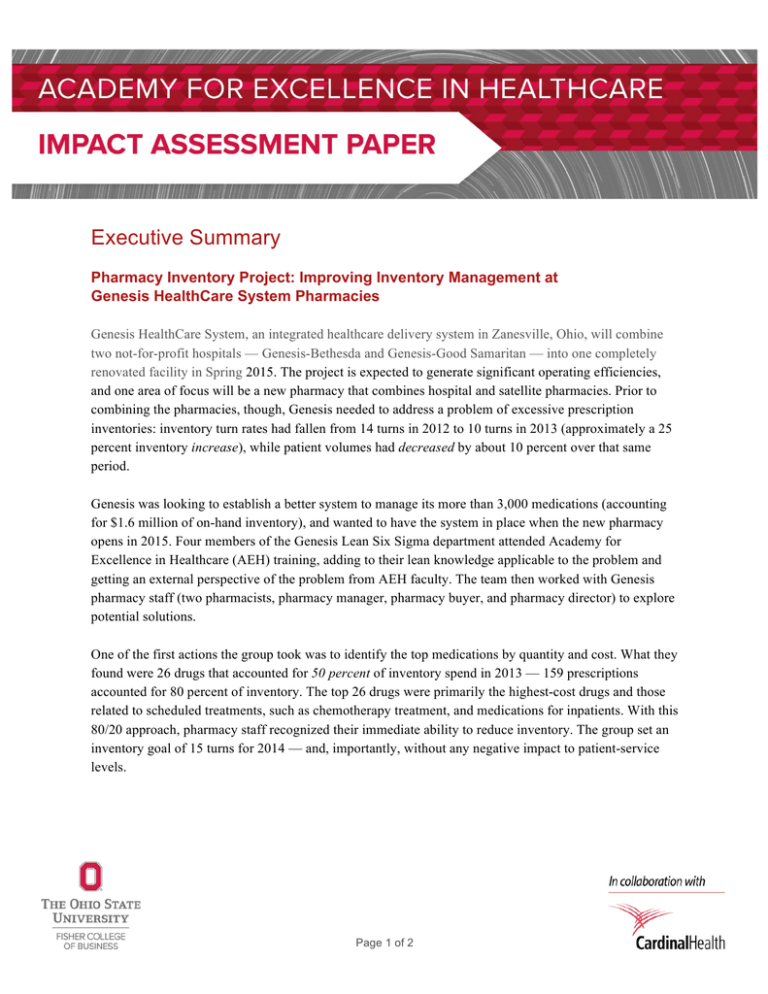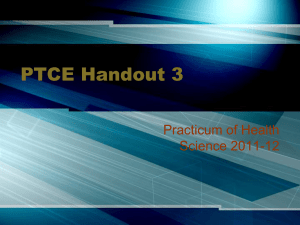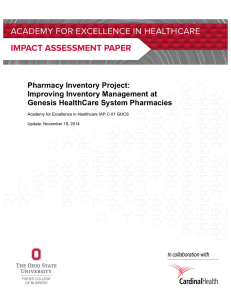Executive Summary Pharmacy Inventory Project: Improving Inventory Management at
advertisement

Executive Summary Pharmacy Inventory Project: Improving Inventory Management at Genesis HealthCare System Pharmacies Genesis HealthCare System, an integrated healthcare delivery system in Zanesville, Ohio, will combine two not-for-profit hospitals — Genesis-Bethesda and Genesis-Good Samaritan — into one completely renovated facility in Spring 2015. The project is expected to generate significant operating efficiencies, and one area of focus will be a new pharmacy that combines hospital and satellite pharmacies. Prior to combining the pharmacies, though, Genesis needed to address a problem of excessive prescription inventories: inventory turn rates had fallen from 14 turns in 2012 to 10 turns in 2013 (approximately a 25 percent inventory increase), while patient volumes had decreased by about 10 percent over that same period. Genesis was looking to establish a better system to manage its more than 3,000 medications (accounting for $1.6 million of on-hand inventory), and wanted to have the system in place when the new pharmacy opens in 2015. Four members of the Genesis Lean Six Sigma department attended Academy for Excellence in Healthcare (AEH) training, adding to their lean knowledge applicable to the problem and getting an external perspective of the problem from AEH faculty. The team then worked with Genesis pharmacy staff (two pharmacists, pharmacy manager, pharmacy buyer, and pharmacy director) to explore potential solutions. One of the first actions the group took was to identify the top medications by quantity and cost. What they found were 26 drugs that accounted for 50 percent of inventory spend in 2013 — 159 prescriptions accounted for 80 percent of inventory. The top 26 drugs were primarily the highest-cost drugs and those related to scheduled treatments, such as chemotherapy treatment, and medications for inpatients. With this 80/20 approach, pharmacy staff recognized their immediate ability to reduce inventory. The group set an inventory goal of 15 turns for 2014 — and, importantly, without any negative impact to patient-service levels. Page 1 of 2 The improvement team and pharmacy staff mapped the value stream of activities for the top medications — order, receive, stock, pull, distribute, administer, and return. This revealed a need for more and better information — such as on-hand inventory, lead time, projected turns, demand — which could help them accurately determine purchase quantities (what, when, and how much). After studying various countermeasures that could be used, the pharmacy staff chose a visual kanban system with medicationordering criteria based on minimum inventory levels (the maximum quantity used multiplied by the lead time for the drug, which for most was three days on hand) and maximum Pharmacy Kanban inventory levels (highest available quantity necessary to cover unusual events, set at one week supply). The improvement team had calculated a potential inventory cost savings of between $360,000 and $500,000. Pharmacy staff had realized $346,000 of that total by November 2014, and overall inventory turns had risen to 13 turns. The pharmacy staff continues to add prescriptions to the kanban system, analyzing additional medications in batches of 10 to 15 prescriptions, and confirming the inventory system works and is sustainable for the additions. Source: Genesis HealthCare System Read the full study of the Genesis HealthCare System Pharmacy Inventory Project, which shows how standardized techniques (kanban system with minimum/maximum inventory levels) were used to reduce medication inventory levels without negatively affecting patient care; lower costs; improve pharmacy operations; and enable staff to more readily and effectively recognize and solve problems. About the Academy for Excellence in Healthcare: AEH blends in-person class time with hands-on project work, interactive simulations, and recurrent coaching, all aimed at helping healthcare teams spark actionable change at their organization. To learn more about AEH, contact Margaret Pennington, Faculty Director, or Beth Miller, Program Director. Page 2 of 2




